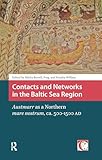Contacts and Networks in the Baltic Sea Region : Austmarr as a northern mare nostrum, ca. 500-1500 AD / ed. by Kendra Willson, Frog, Maths Bertell.
Material type: TextSeries: Crossing Boundaries: Turku Medieval and Early Modern Studies ; 11Publisher: Amsterdam : Amsterdam University Press, [2019]Copyright date: ©2019Description: 1 online resource (296 p.) : 25 halftones, 10 line artContent type:
TextSeries: Crossing Boundaries: Turku Medieval and Early Modern Studies ; 11Publisher: Amsterdam : Amsterdam University Press, [2019]Copyright date: ©2019Description: 1 online resource (296 p.) : 25 halftones, 10 line artContent type: - 9789462982635
- 9789048532674
- 914.804 23
- D965 .C668 2018
- online - DeGruyter
- Issued also in print.
| Item type | Current library | Call number | URL | Status | Notes | Barcode | |
|---|---|---|---|---|---|---|---|
 eBook
eBook
|
Biblioteca "Angelicum" Pont. Univ. S.Tommaso d'Aquino Nuvola online | online - DeGruyter (Browse shelf(Opens below)) | Online access | Not for loan (Accesso limitato) | Accesso per gli utenti autorizzati / Access for authorized users | (dgr)9789048532674 |
Frontmatter -- Table of contents -- List of maps, figures and tables -- Note on alphabetisation -- Preface -- Introduction: Looking across the Baltic Sea and over linguistic fences -- Section 1. Mental maps -- 1 The northern part of the Ocean in the eyes of ancient geographers -- 2 Austmarr on the mental map of medieval Scandinavians -- 3 The connection between geographical space and collective memory in Jómsvíkinga saga -- Section 2. Mobility -- 4 Rune carvers traversing Austmarr? -- 5 Polish noble families and noblemen of Scandinavian origin in the eleventh and twelfth centuries -- 6 A medieval trade in female slaves from the north along the Volga -- Section 3. Language -- 7 Ahti on the Nydam strap-ring -- 8 Low German and Finnish revisited -- Section 4. Myth and religion formation -- 9 Mythic logic and meta-discursive practices in the Scandinavian and Baltic regions -- 10 The artificial bride on both sides of the Gulf of Finland -- 11 Local Sámi bear ceremonialism in a Circum-Baltic perspective -- 12 Mythologies in transformation -- Contributors -- Indices
restricted access online access with authorization star
http://purl.org/coar/access_right/c_16ec
Since prehistoric times, the Baltic Sea has functioned as a northern mare nostrum - a crucial nexus that has shaped the languages, folklore, religions, literature, technology, and identities of the Germanic, Finnic, Sámi, Baltic, and Slavic peoples. This anthology explores the networks among those peoples. The contributions to Contacts and Networks in the Baltic Sea Region: Austmarr as a Northern mare nostrum, ca. 500-1500 ad address different aspects of cultural contacts around and across the Baltic from the perspectives of history, archaeology, linguistics, literary studies, religious studies, and folklore. The introduction offers a general overview of crosscultural contacts in the Baltic Sea region as a framework for contextualizing the volume's twelve chapters, organized in four sections. The first section concerns geographical conceptions as revealed in Old Norse and in classical texts through place names, terms of direction, and geographical descriptions. The second section discusses the movement of cultural goods and persons in connection with elite mobility, the slave trade, and rune-carving practice. The third section turns to the history of language contacts and influences, using examples of Finnic names in runic inscriptions and Low German loanwords in Finnish. The final section analyzes intercultural connections related to mythology and religion spanning Baltic, Finnic, Germanic, and Sámi cultures. Together these diverse articles present a dynamic picture of this distinctive part of the world.
Issued also in print.
Mode of access: Internet via World Wide Web.
In English.
Description based on online resource; title from PDF title page (publisher's Web site, viewed 02. Mrz 2022)


